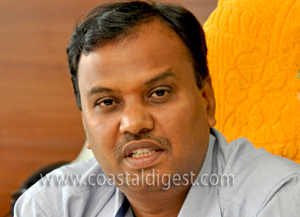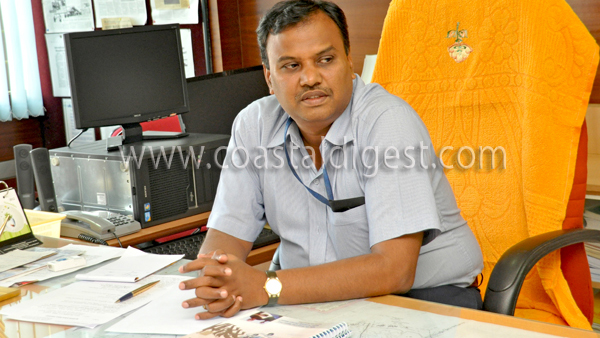
J T Radhakrishnan, a native of Ananthpura in Andhra Pradesh has succeeded M R Vasudev as the Director of Mangalore International Airport following his retirement. A graduate in B.Tech (Civil), Mr Radhakrishnan was also a part of the new terminal building and runway projects at Mangalore Airport. In 2010, he received ‘Best Engineer Award’ for his contribution in project and planning of New Integrated Terminal Building (NITB) at Mangalore. Excerpts from the interview:
You are basically from Andhra Pradesh. Could you shed some light on the Karnataka connection that you have had?
It’s been a long connection. My mother hails from Davanagere. My wife is also from Shimoga. So I have had links with Karnataka from long. It was just that my father had roots in Andhra Pradesh, which is why I happened to take birth and was brought up there. Most of my relatives stay in the border areas. So I have good connections in both the states that way.
How did you get into the Aviation field?
After my engineering degree from Ananthpur, Hyderabad, I joined as Manager (Engineering, Civil). I wrote a national level examination and my recruitment with the Airports Authority of India (AAI) followed in 1993. For some time, I worked for the All India Radio (AIR) as an engineer, taking care of the construction work of AIR stations etc.
You were associated with the building process of the new airport terminal here before. Could you share some of your experiences?
I joined AAI in 1993 in Delhi. I worked in Chennai for four years and was then shifted to Calicut Airport. I was involved in the construction of the runway at the Calicut Airport which was a huge task. What it did was it gave me experience which helped me in my capacity as the main project engineer here in Mangalore when this new terminal building was being built. I could carry out the works concerning the tunnel building, runway and other development works from 2004 to 2010. I was involved in all engineering related works and there was good cooperation from all both in senior as well as junior levels.
I was in Mangalore when the air crash took place. It was a tragedy which we could not avoid. But we immediately sprang into action in terms of coordination. The runway was made operational again. Flights were stranded which had to move. People had booked flights, so services had to be normalized again.
The runway and building work of this airport was a challenge. It is an exciting runway in the sense that it is not a normal runway with the valleys and other factors coming in. So technically, our work demanded a lot of precision. This is the first concrete runway to be built in the whole of India. We took that decision owing to the kind of rains that pour in here. We created a record of sorts by completing 55,000 cubic metres of concrete runway in a span of two months. It was a great achievement since we were doing about a 1,000 cubic metres of concrete in a single day. A lot of hard work has gone behind it and the work was pushed and completed at a fast pace. After that I took care of the building work. It is being appreciated by one and all today, which has brought immense contentment.
What about the extension of the runway?
We have asked for the additional land from the state government. The government has to take up the matter of land acquisition and hand it over to us. But land acquisition is one matter and the expenditure is another. There is a big valley which needs to be filled which involves a lot of cost. But it is not an impossible task. It can be done with the cooperation of all concerned stakeholders. The same thing was done at Calicut airport. We created a runway of 1.2 kms by filling up a valley of a similar nature. So when it can be done there, there is no reason why it cannot be done here. The Calicut runway was built in 1980s. We extended it in 1998. The Calicut airport has developed well but it is not likely to pose a threat to Mangalore airport. Almost 2 lakh people from Mangalore and DK area are in Gulf. There is growth, more people are visiting Gulf, and business dealings are taking place, so I don’t think the Airport has reasons to worry.
This is the first time you have been appointed as an Airport Director. Do you feel the pressure of expectation especially after the good work put in by your predecessor MR Vasudeva?
People will definitely expect more from me. But the good thing is that many major hurdles have already been passed. The completion of this building, construction of the runway, international status for the airport…the big things have been achieved. Now it is more about maintaining the smooth flow of things and extension work. Of course, most works that Mr. Vasudeva was carrying out, I was a part of them. I will always be proud that I was a part of his team. When his efforts are lauded, I also feel happy because I too was involved. But I will try newer things because there are expectations. I see the Airport growing further.

What plans do you have of developing the airport further?
I want to see more foreign airlines operate at our airport and greater convenience to the passengers as well as airline operators. Extension of runway is another important pending job. The international cargo services are expected to start in three months. A control tower of 25 mtr height is under construction. The technical building will also come up. Once it is completed, all equipments whether concerning radar, area control or other navigational equipments which are currently at the old airport region will be shifted there. The building is expected to be ready by June 2013 and everything is likely to be operational from December 2013. The parallel taxiway along the runway will also come up in the future. Now that we have got the international status, there will be greater air traffic and to reduce runway occupancy time (time spent by an aircraft on the runway while landing and take off) the parallel taxiway is necessary so that space is created for other airlines and there is no wastage of time. This work is expected to complete by March 2014.
Has there been an increase in number of flights after international status?
No. So far, the same number of flights is operating which were doing so prior to the grant of international status. Just that Spice Jet has introduced a flight to Bangalore and Air India has introduced another flight to Bangalore for four days in a week. These two have been the additional flight services made last month. Jet Aiways, Air Arabia, Etihad and other such airlines may come but even if they are interested, they will get in touch with authorities in Delhi first. Approaching us is the final step of sorts after approval is granted at Delhi. We will have to wait a little more. The international status declaration has been made very recently. So the processes will take more time.
What other interests do you have?
I like spending time reading newspapers and magazines and watching TV. I do walking every morning and I love walking on the Mangalore streets. I have been here in Mangalore from 2004. In 2010 I was transferred to Coimbatore but now I am back to this city.







Comments
Add new comment